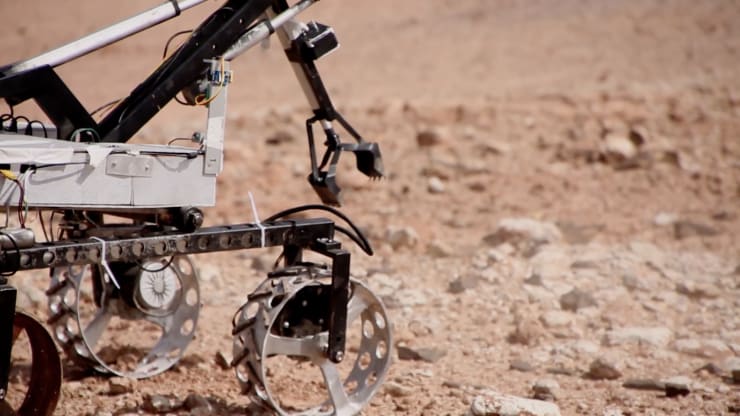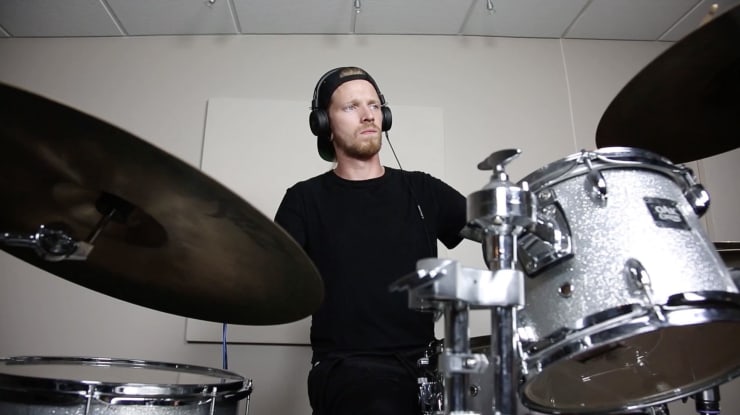-

The videos in Between Art and Science attest to Janet Biggs' ongoing interest in scientific research and its revolutionary potential. These single-channel works find inspiration in the advances being made by scientists across the globe, from the cognitive to the physical and the planetary.
Can't Find My Way Home compares the winding pathways of an Alzheimer's patient's brain with an underground labyrinthine salt cavern in Merkers, Germany. In Seeing Constellations in the Darkness Between Stars, would-be Mars Rovers rumble across the Utah desert while cybernetic drummer Jason Barnes hammers out a turbulent beat.
Both of these videos are rooted in hope: science as witnessed here is employed to combat dementia, make AI-boosted prosthetic limbs, and further the mission to Mars. Biggs sees grounds for optimism in these efforts, even as she questions the thresholds of existence and possibility. Her work is thoughtful in tone and pacing, imbuing her subjects with an elegant beauty.
-
Can't Find My Way Home was commissioned by the Blaffer Art Museum at the University of Houston, Texas, with a four-channel version of the work screened in the artist's solo exhibition Echo of the Unknown. The video is one of several from Biggs' oeuvre that explore the role of memory in the construction of identity, and was inspired by memories of her grandfather.
An avid collector of minerals, Biggs' grandfather was able to recall the most obscure names of samples in his collections and the locations of their acquisition even as he was losing the ability to remember or identify family members and close friends around him. In 1980, Merkers miners discovered a unique and extraordinary geological anomaly 800 meters below the surface: a cavern filled with giant, glistening geometric crystals, some measuring more than a meter in length. Entering this natural wonder is like walking into a mammoth geode, an experience that is both immersive and otherworldly.
-
Can’t Find my Way Home juxtaposes footage shot in the crystal caverns below the German Merkers salt mine with documentation of neurological research conducted in laboratories in New York and Houston. The comparison makes the visual connection between the structure of these salt crystals and the proteins that determine the biochemical conditions of a hyper-excited brain, such as one afflicted with Alzheimer’s. By physically exploring the Merkers crystal cavern, Biggs figuratively sets out to investigate the diseased brain of her grandfather. As she climbs through rocky passes and symbolically retraces fading memories, she experiences disorientation and confusion, some of the same symptoms endured by Alzheimer’s patients.
-
The Making of Can't Find My Way Home
-
Further Viewing
-
Janet Biggs on the exhibition Echo of the Unknown at the Blaffer Art Museum, University of Houston, Texas
-
-
Seeing Constellations in the Darkness Between Stars explores the potential of robotics in both the celestial and earthly realms. A four-channel version of the work premiered at the Museo de la Ciencia y el Cosmos in Tenerife in 2018.
Earlier that same year, Janet Biggs completed a residency at the Mars Desert Research Station (MDRS) in Utah. While there she filmed the Mars Society's annual University Rover Challenge, in which teams from around the world face off, building robots that could one day serve as Rovers on the Red Planet. The robots have to complete various tasks in order to win, including picking up samples, drilling into the earth, and crossing rough terrain.
-
The Rover footage is combined with that of drummer Jason Barnes at Georgia Tech's Center for Music Technology. A longtime musician, Barnes lost part of an arm in a workplace accident. After seeing a video of robot musicians developed by Gil Weinberg, founding director of the Georgia Tech Center for Music Technology, Barnes contacted Weinberg and the two men began a collaboration. Barnes was fitted with a robotic arm developed by Weinberg, which sports two drumsticks. One is controlled by Barnes and one is controlled by Artificial Intelligence, which improvises off Barnes’ drumming. With this robot-enhanced prosthetic, Jason is able to drum faster than what is humanly possible.
-
At the apex of the video, the complicated link between man and machine becomes most evident as Barnes' drumming crescendos and stops while one of the robots tumbles down a hill. This suggests both the possibility and the limitation of robotics, while shining a spotlight on the creativity of human researchers.
Mathematics and music are handled by similar regions in our brains. In Seeing Constellations in the Darkness Between Stars, music plays an overwhelming role in awakening our subjectivity and bridging the gap between man and man-made machines, between creativity and control, strength and frailty, and between our infinitesimal position in the universe and the heroic paths individuals may take.
-
The Making of Seeing Constellations in the Darkness Between Stars
-
Further Viewing
Between Art and Science
Past viewing_room



































